Mud Cracking
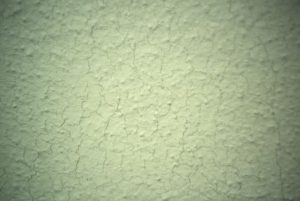
Cause
Caused by the application of a pigmented matt emulsion over a surface previously finished with a vinyl silk emulsion. This is where the adhesion of the most recently applied coating is poor and the underlying material offers no keying properties for when the last coat of paint is applied.
Remedy
Rub down with a “Scotch Brite” pad and apply a thinned-down coat of good quality vinyl matt emulsion. If this fails to cure the problem then an acrylic primer should be tried. It may be necessary to reinstate with a vinyl silk or satin emulsion.
Mud Cracking
Cause
Caused by the application of a matt emulsion over a surface previously finished with a vinyl silk emulsion. This is where the adhesion of the most recently applied coating is poor with the underlying silk finished material offering no keying properties for the newly applied matt finish.
Remedy
Rub down with suitable abrasive paper and to a trial area apply a coat of good quality vinyl matt emulsion, thinned a necessary. If this fails to cure the problem, then an acrylic primer should be tried. It may be necessary to reinstate with an emulsion or acrylic with a higher sheen finish.
Copper corrosion
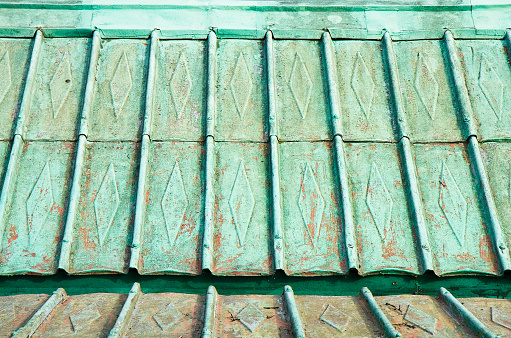
Cause
Copper corrosion is caused when oxygen and water come in contact with untreated copper that is exposed to air and moisture in the atmosphere. This is also referred to as copper carbonate and copper hydroxide.
Solution
Remove the contamination with a solution of acetic acid (vinegar); salt can also help to clean a copper surface. There are also many household products available which will be successful.
If untreated copper is required to be painted then primers for non ferrous metals are available. For domestic heating and plumbing systems clean and abrade the copper surface followed by priming and finishing with suitable oil based paint systems.
If the bare copper appearance is preferred then treating with a clear shellac or clear lacquer can be considered.
Note: Black spots can appear when oil based coatings are applied to an unclean surface.
Rivelling
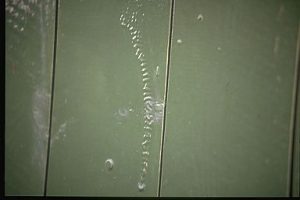
Rivelling
Cause
Two problems in one. General poor application causing the material to sag and shrivel. Rivelling is caused by the film of a thick coating drying too quickly and skinning before the underlying material is dry.
Remedy
Once the entire coating is dry and hard, flat down using wet or dry carborundum paper, wet, with warm water and add soap. Thoroughly rinse with clean water and allow to dry before re-painting with additional coats.
Moisture ingress
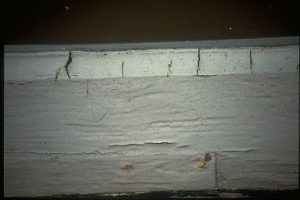
Moisture ingress
Cause
Old defective putties allowing moisture ingress into the timber resulting in the wood splitting and corrosion of the glazing pins.
Remedy
Hack out the old putties and replace after priming the rebates. Burn off remaining paint coatings followed by thoroughly sanding down, clean nail heads or replace.
Treat knots, etc. if present and prime overall. A general purpose primer suitable for wood and metal is usually recommended as this will contain rust inhibitive pigments.
This should be followed by an undercoat and finishing system oil or water based.
Chalking Oil Paints
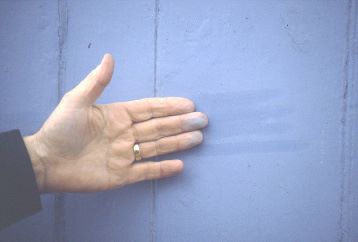
Chalking of resin based paints.
Cause
Overall or partial chalking and loss of gloss is due to the erosion of the paint film being exposed to UV light.
Certain colours contain pigments that are not light fast, therefore are more inclined than others to fade and chalk with age when exposed to ultra violet rays.
Solution.
Wash down with sugar soap and water, rinse, allow to dry, sand down and paint with the required system.
De-Natured Wood
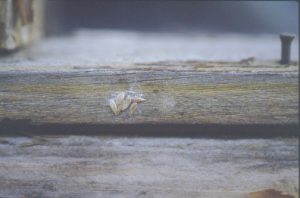
De-natured wood
Cause
Unprotected wood which has been exposed to the elements (U.V. light) and has become extremely dry causing a breakdown of the natural cells.
Solution
Mechanically sand down to remove the top layer of wood followed by priming with an oily wood primer. Standard primers if used should be thinned to obtain penetration of the wood,
Standard alkyd systems can then be applied.
NB. If the de-natured wood is not removed and replaced then further paint failures are likely.
Organic Growths. Lichen, Algae, Mould.
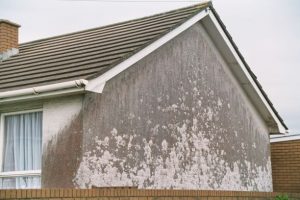
Lichen/ algae organic growth
There many Types of Lichen and can be present in different colours including grey, orange, red, black, yellow or green. Lichens normally form a crust like surface on the surface.
Algae is normally green in colour although can also be black, red, orange or yellow and forms a matt- like film on the surface or streaks down the surface.
Fungi colours can be black, orange, yellow, red or brown and form as a film or spots.
Cause
Generally occurs in conditions where the surface remains damp and to the northerly and westerly elevations.
Textured surfaces are more prone to holding moisture than smooth surfaces
When present on exterior surfaces, it is most likely to be associated with moisture in the substrate and lack of air flow; close proximity to trees can also be the cause.
Lichen on interior walls is due to heavy condensation and the lack of air flow
Solution
For exterior walls power wash to remove all mould / algae back to a clean surface. It may be necessary to pressure wash or light sand blasting.
Apply two coats of recommended fungicidal wash, allow 24 hours drying between coats and allow the surface to dry out.
Apply selected manufactures masonry finish in accordance with their recommended instructions.
For interior walls remove by heavy scrubbing and washing with a solution of bleach and or a proprietary fungicidal wash back to a clean surface. Once the surface has dried then apply the selected wall finish strictly in accordance with manufactures instructions.
Plywood Checking
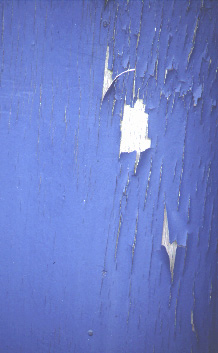 Plywood Checking
Plywood Checking
Cause
Breakdown of a paint system applied to plywood which has “checked” (the ply surface splitting) allowing moisture to enter and causing detachment of the paint coatings.
Solution
Scrape back to a firm edge by removing all loose and defective paint. A system based on glass fibre weave membrane may help to overcome further problems. Textured paints have proven to be more successful on this type of substrate than smooth coatings.
Galvanized Steel Flaking
Galvanised steel flaking
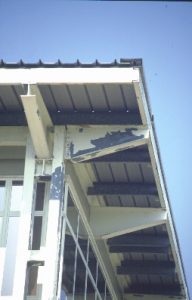
Cause
The surface of new galvanised (zinc coated steel) sis is very smooth, therefore , if to be painted the steelwork prior to painting requires special preparation. If not then the adhesion onto the untreated surface will be suspect and ultimately flaking of the applied coatings can occur.
Solution
All the defective coatings should be removed back to the zinc coated steel.
The most effective method is to have the surface prepared by sweep blasting to remove all defective paint. This is carried out by specialist contractors who use grit or sand to produce a fine texture surface without penetrating the zinc coating.
If the above is not possible then removing the flaking paint coating can be done by chemical or mechanical means; the exact method will depend on the nature of the paint coating which has been applied. The resultant surface should be prepared to provide a suitable key for priming coats.
How can I tell if the steel is galvanised?
The galvanised zinc coated finish is non-metallic therefore using a normal magnet will confirm.
See galvanised specification
For further information: What is steel Galvanized Steel: https://www.galvanizing.org.uk/galvanizing-process/
Wood Stain Algae
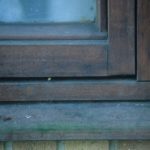 Wood Stain Algae
Wood Stain Algae
Staining
Cause
Organic growths as a result of the timber having been exposed to rain water with the moisture content in the wood remaining high. Most prevalent when shaded from direct sun light.
Remedy
Once the staining has occurred, thorough sanding down is needed to remove all the surface contaminates back to bare timber followed by washing down with a fungicidal solution and allowed to dry, followed by recoating with the selected wood finish in accordance with manufacturers instructions.
Note: If it has not been possible to remove all the discolouration then a darker shade of finishing colour will have to be considered.
Alternatively an opaque microporous coating could be considered.